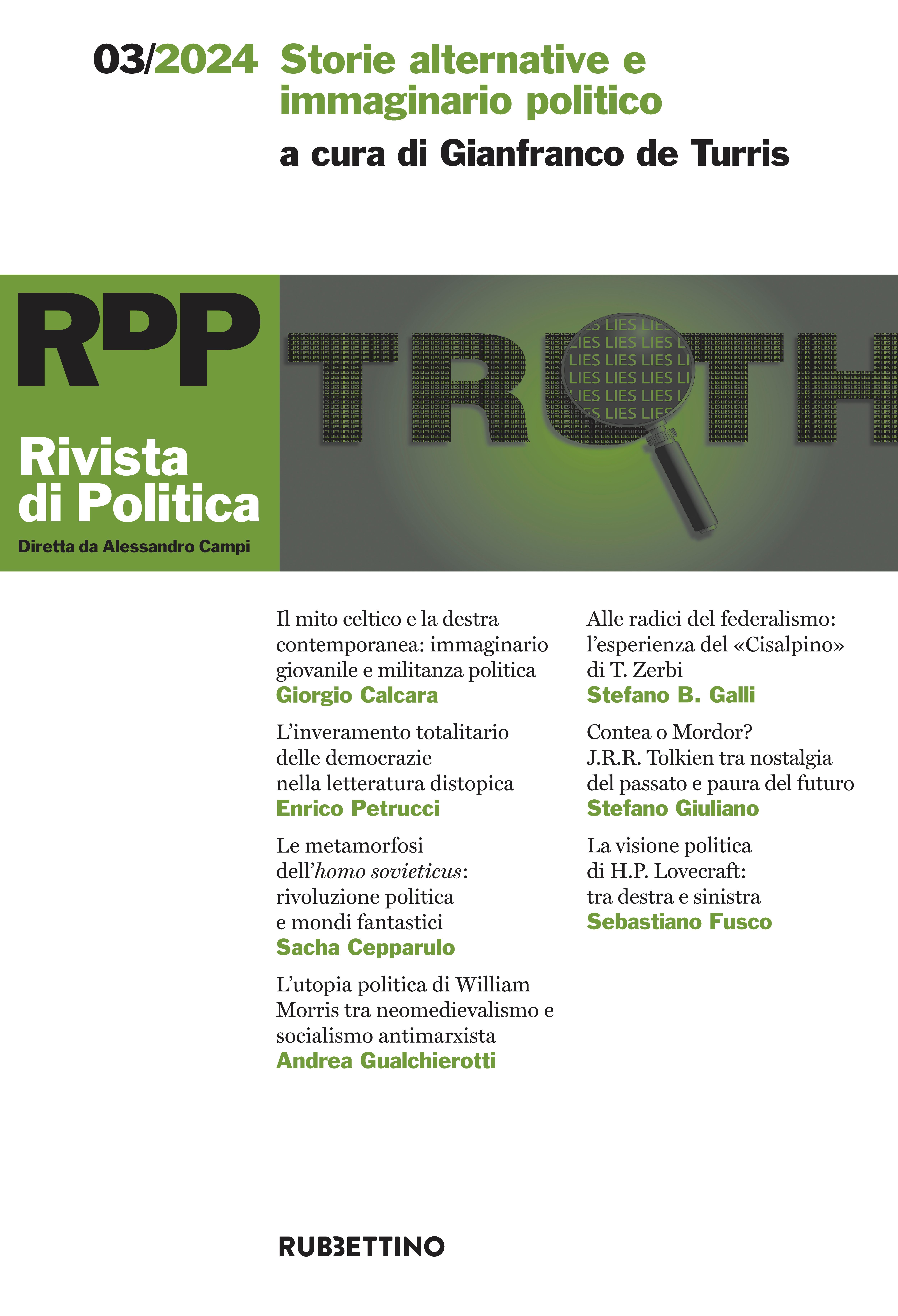03/2024 – Storie alternative e immaginario politico
ISSN: 2037-495X
8,50€ – 11,00€
Descrizione
dossier: storie alternative e immaginario politico
Immaginario e politica, ovvero cosa è e cosa non è la storia alternativa Gianfranco de Turris
Non solo totalitarismi: le distopie “democratiche” Enrico Petrucci
Quando l’arte bruciava più delle molotov. Il sogno infranto dell’arte psichedelica italiana Guido Andrea Pautasso
Rivoluzione, alieni e bambini: la costruzione dell’homo sovieticus Sacha Cepparulo
Celtomania. Il mito celtico tra folk revival, neopaganesimo e appropriazione politica Giorgio Calcara
La terra di mezzo di Tolkien tra eutopia e distopia Stefano Giuliano
Upmeads versus Utterbol. Medioevalismo sociale vittoriano ed etica in La fonte ai confini del Mondo di William Morris Andrea Gualchierotti
Il percorso politico di H.P. Lovecraft Sebastiano Fusco
storia del pensiero politico
Il federalismo radicale del «Cisalpino» Stefano Bruno Galli
Notizie sugli Autori
Abstracts
Abstracts
Gianfranco de Turris, Imagination and Politics, or What Alternative History Is and Is Not
When discussing the relationship between Imagination and Politics, one immediately thinks about how the former influences the latter, which can happen in various ways; however, the main way is undoubtedly through the alteration of history as we know it, codified by annals and, indeed, by codes. This alteration offers intriguing perspectives to those who do not wish to remain prisoners of the dictatorship of the Given Fact, commonly known in English as ‘What if?’— a phrase derived from a famous anthology by J. C. Squire in 1931, translated into Italian as Se le cose fossero andate diversamente.
Enrico Petrucci, Not Just Totalitarianism: ‘Democratic’ Dystopias
The dystopian novel is generally regarded as a reflection on the totalitarian regimes of the twentieth century. However, by examining the origins of dystopia and exploring the contexts in which the most representative works of the genre emerged, it is possible to read dystopia as a critique of the potential excesses of social democracies and liberal democracies. Through the analysis of elements from the works of Jerome K. Jerome, Eugenij Zamjatin, Aldous Huxley, George Orwell, Anthony Burgess, Ray Bradbury, and Ayn Rand, the contribution aims to identify a path that highlights the dystopian elements arising from the paradoxes of democracies rather than from the dictatorships per se.
Guido Andrea Pautasso, When Art Burned More than Molotovs: The Shattered Dream of Psychedelic Art
Psychedelia and the Beat and Hippie counterculture represented a creative earthquake in the international artistic landscape between the late 1950s and the 1970s. In Italy, during the upheaval of ’68, the youth maelstrom revealed itself as an existential movement with a strong imaginative and subversive component. Psychedelic Art represented the creative wing of a generation of rebels who experienced a collective hallucination but confronted the conformist politics they themselves dreamed of revolutionizing: a true shattered dream.
Sara Cepparulo, Revolution, Aliens, and Children: The Construction of Homo Sovieticus
Through the description of various types of humans, superhumans, and aliens, alternative socio-economic contexts, and extraterrestrial civilizations that are not necessarily rational, the works of the Strugatsky brothers grapple with the complexity of all noble human aspirations as well as the problematic consequences of those aspirations, compelling the reader to consider perspectives that are both ‘alien’ and authentic. This contribution outlines an ideal path through some of the most well-known works of these writers, focusing on the analysis of the formal and content-related solutions they employed.
Giorgio Calcara Celtomania: The Celtic Myth in Folk Revival, Neopaganism, and Appropriation
By the end of the 1960s, a phenomenon that had long been underway and known in the rest of Europe emerged in Italy: the revival of Celtic culture, which, with its dual aspect—light and folkloric music and legends on one side, but also imbued with powerful and shadowy spiritual allegories—captivated and influenced the political youth militancy of that period, ultimately defining the neofascist movements first and, subsequently, the rise of Padanian Lega.
Stefano Giuliano, Tolkien’s Middle-earth: Between Utopia and Dystopia
The text examines the terms Utopia and Dystopia to assess the possibility of applying these conceptual categories to one of the most important novels of the 20th century: The Lord of the Rings by J.R.R. Tolkien. A complex work that incorporates elements of both utopian and dystopian nature.
At the core of the novel, in fact, is a reflection on an ethical confrontation that mirrors the dangers of power and industrialization. The analysis focuses, in particular, on two contrasting places, the Shire and Mordor, exploring how Tolkien uses these categories to evoke nostalgia for a lost past and unease for a threatening future, aligning with a literary tradition that examines the tensions between utopia and dystopia throughout history
Andrea Gualchierotti, Upmeads vs. Utterbol: Victorian Social Medievalism and Ethics in The Well at the World’s End by William Morris
By retracing the setting and characters of one of William Morris’s most famous novels, the ideological and religious influences of the Morrisian Weltanschauung are extrapolated, and the traits of the ideal society envisioned by the author are identified. This society consists of a blend of an aestheticized Middle Ages and a pragmatic adherence to an anti-Marxist socialism, representing the poles of English metapolitical reflection of the time. The fantastical nature of the narrative, like a mirror, thus unites utopian elements and religious meditation on the Machine and Modernity.
Sebastiano Fusco, The Political Journey of H. P. Lovecraft
For several years now, Lovecraft has been under attack, especially from far-left intellectual factions, accused of racism, homophobia, extreme conservatism, and similar claims. In reality, what emerges from an analysis of his writings is that he, during his youth spent in a confined environment in the most conservative region of the United States, merely reflected the dominant thinking of the society and political system of his time, where ‘politically correct’ thinking led to the cultural and social segregation of non-‘WASP’ (White Anglo-Saxon Protestant) ethnic minorities, as also evident in great American literature up until World War II. However, he was much quicker to liberate himself from these constraints than the prevailing culture of his country and, generally, in all of the West: so much so that in 1936, shortly before his death, he wrote that a child of any ethnicity ‘if raised by a good American, would become a good American.’ This concept began to spread, particularly in the Deep South of the United States, only in the late 1960s, and not without extreme social tensions. Lovecraft arrived at this realization on his own, thirty years earlier.
Stefano Galli, The Radical Federalism of the ‘Cisalpino’
After 8 September 1943, a group of members of the clandestine Christian Democrats, led by Professor Tommaso Zerbi, founded the Cisalpino movement which claimed, in the perspective of liberation and the re-foundation of the State, a federal political order on a cantonal basis inspired by the Swiss model. On 27 April 1945 the first issue of the national federalist weekly ‘Il Cisalpino’ was published, in which a group of very promising young people collaborated, from Gianfranco Miglio to Antonio Amorth, from Aldo De Maddalena to Gianfranco Bianchi. The fierce editorial adventure lasted a few months and ended, also due to a difficult relationship with the leaders of the DC, at the end of 1945.



